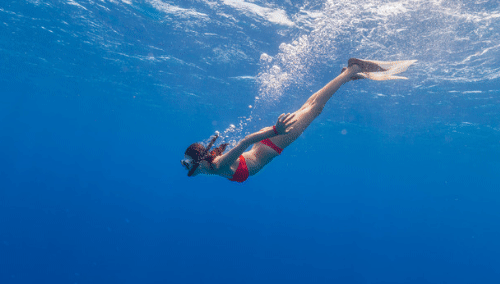
Free diving is one of the most intense and dangerous sports. Not knowing what you are doing can be fatal. Even trained competitors get hurt in controlled situations. The danger that inherently comes with diving to great depths without an oxygen supply only highlights the need for proper training.
What Happens When You Dive?
Several changes happen within the body when diving, and understanding these features is crucial to improving diving ability. First, the heart rate drops dramatically through a process called bradycardia. Basically, your heart rate drops below 60 beats per minute. This is an oxygen preservation response. The less your heart pumps oxygen-rich blood through your body, the less oxygen your body consumes.
Your spleen contracts and releases its store of oxygen-rich blood cells into your blood stream. While this process is not very well developed in humans, it is still a reaction to cutting off fresh oxygen to the lungs.
Vasoconstriction shifts blood from your peripherals to the vital organs and supporting processes, which includes muscles used by the respiratory system. By reducing blood flow to your peripherals, two things happen:
- they are not supplied with as much oxygenated blood; and
- this reduced blood flow cools your peripherals, further lowering their oxygen demand.
Studies have even shown that immediately after holding your breath, your brain cools by 1 degree Celsius per minute.
How Free Divers Train
Not long ago, divers would hyperventilate to reduce the carbon dioxide levels in their body and subsequently reduce the sensation of needing to breathe while under water. It was found that while it might reduce the sensation of needing to breathe, it did not actually provide more oxygen while under water. Hyperventilation has since been replaced by breathe-ups.
Breathe-ups are typically done just before diving, floating face down in the water, and breathing through a snorkel. One inhales, and then exhales for twice as long. So, if you inhale for two seconds, you would exhale for four. The goal of breathe-ups is to be as relaxed as possible releasing tension in your muscles.
Apnea walks are a dry training technique intended to improve anaerobic performance. In an apnea walk, you breathe in, breathe out (emptying the lungs completely), and take one final deep breath. At this point you hold that breath and walk for as long as you can until you cannot resist the need to breathe any longer.
To empty the lungs completely, and fill them again, free divers need to practice belly breathing. This important exercise allows deeper breaths and a more complete exhalation of carbon dioxide. To do this, place your hands on your stomach and chest. When executed properly, your stomach should inflate as you inhale, while your chest remains still. This signifies that you are breathing from the diaphragm, and not just the muscles around the rib cage.
Finally, just before diving, divers practice the same breathing technique done before an apnea walk: breathe in, breathe out completely, and take one final deep breath for the dive.
Improve Dry Training With PowerLung
PowerLung is used to train the strength of the respiratory muscles. It is the only breathing trainer that exercises muscles on both inhalation and exhalation. Training the respiratory muscles allows deeper breaths and greater exhalation. This is especially important for free divers before they dive, allowing them to almost completely empty their lungs of carbon dioxide (outside of Residual Volume) and breathe in the highest amount of oxygen.
Add PowerLung to your training routine. The benefits are many.
Take your apnea walks further by training your lungs to exhale more completely and inhale more oxygen, allowing your body to go longer without needing to breathe. Belly breathing uses your diaphragm, but exercising the diaphragm allows it to create a stronger vacuum as it expands your chest cavity and pulls in more air in a single breath.
And, while PowerLung cannot be used in conjunction with a snorkel, by having trained your respiratory muscles to be stronger prior to underwater activities, you can breathe in more oxygen on your final breath before the dive.

